
ICCROM_ICS11_History_en
.pdf
for more generic training for decision-makers and managers. Regional delivery of more specialist programmes could fulfil a priority need of Member States and funding agencies and deliver local capac- ity-building so that ultimately they could be funded and sustained by themselves.256 The result of these various considerations was that Council decided in 1998 to discontinue the ‘classic’ programmes and to concentrate on developing activities in the regions.
PREMA
The PREMA Programme for the preventive conservation of collections in Sub-Saharan African museums had been established in 1986 under Erder’s directorship and Gaël de Guichen’s co-ordination. The programme was based on five different types of activities: nine-month international university courses, three-month national/sub-regional courses, one-week seminars for Directors, staff development activities and technical assistance. The first major event was the international university course organized at ICCROM and recognized by the University of Sorbonne, Paris. These courses were run at ICCROM from 1986 to 1992, after which they were transferred to African countries: Nigeria (1993), Ghana (1995) and Benin (1997 and 1999). In 1998 there were workshops held in Ethiopia, Ghana, Kenya and Zimbabwe. At the same time, the programme organized national courses in Ghana (1989), Côte d’Ivoire (1990), Zambia (1991), Benin (1992), Madagascar (1994), Zimbabwe (1995), Guinea (1996), Malawi (1997) and Benin (1998). The
Figure 6 17
The building of the Ecole du Patrimoine Africain (EPA) in Porto Novo, Benin
objective of PREMA was “to establish by the year 2000 a network of African professionals who can assume the responsibility of conservation of movable property and future training, to ensure the conservation of sub-Saharan museum collections,”257an objective that was fully realized. (In 2010 a former participant in the PREMA 1986 University Course and subsequently member of ICCROM Staff, Baba Fallo Keita (Mali), was appointed Director of EPA, succeeding another participant of the same Course, Alain Godonou (Benin), on his appointment as Director of the UNESCO Division of Cultural Objects and Intangible Heritage.)
The transfer of the programme to Africa meant not only transferring the activities but also guaranteeing the conceptual, pedagogical, managerial and financial responsibilities. Its success is reflected by comparing the situation in 1989 with that in 1995-96. In 1989 the Co-ordination Team worked at ICCROM and the budget and fundraising were fully ICCROM’s responsibility. In 1995-96 the Co-ordi- nation Team was at the National Museum of Benin and budget management was 70% in the hands of the National Museum, and 30% at ICCROM while fundraising was 20% the responsibility of the National Museum, and 80% that of ICCROM. In 1989 87% of the teachers were from outside Africa while 1995-96 they were only 25%. All this was made possible through efficient fund raising. From 1986 to 1998, 21 agencies and foundations generously contributed to PREMA, amounting to a total of US $6 882 671. The average annual cost of the PREMA Programme was around US $600 000. The university courses, the three-month national courses, the seminars for museum directors and staff development activities were attended by museum staff and directors from some 46 African countries. The Technical Assistance Programme (TAP), was established as part of PREMA in parallel to ICCROM’s general technical assistance activities. Its aim was to offer publications, equipment, conservation materials, teaching tools, communication links and information for African museums. TAP was first managed from ICCROM but then became operational at the Livingstone National Museum as of 1997. The PREMA Programme was reviewed regularly every two years in order to monitor the outcome and plan for the next step.
On 11 November 1998 ICCROM signed an agreement with the National University of Benin (NUB) for the location of the Ecole du Patrimoine Africain (EPA) in a historic building provided by the Government of Benin in Porto Novo and restored in 1997. The EPA aspires to promote culture as a tool of sustainable development through the
 110
110 ICCROM and the Conservation of Cultural Heritage. A history of the Organization’s first 50 years, 1959-2009
ICCROM and the Conservation of Cultural Heritage. A history of the Organization’s first 50 years, 1959-2009
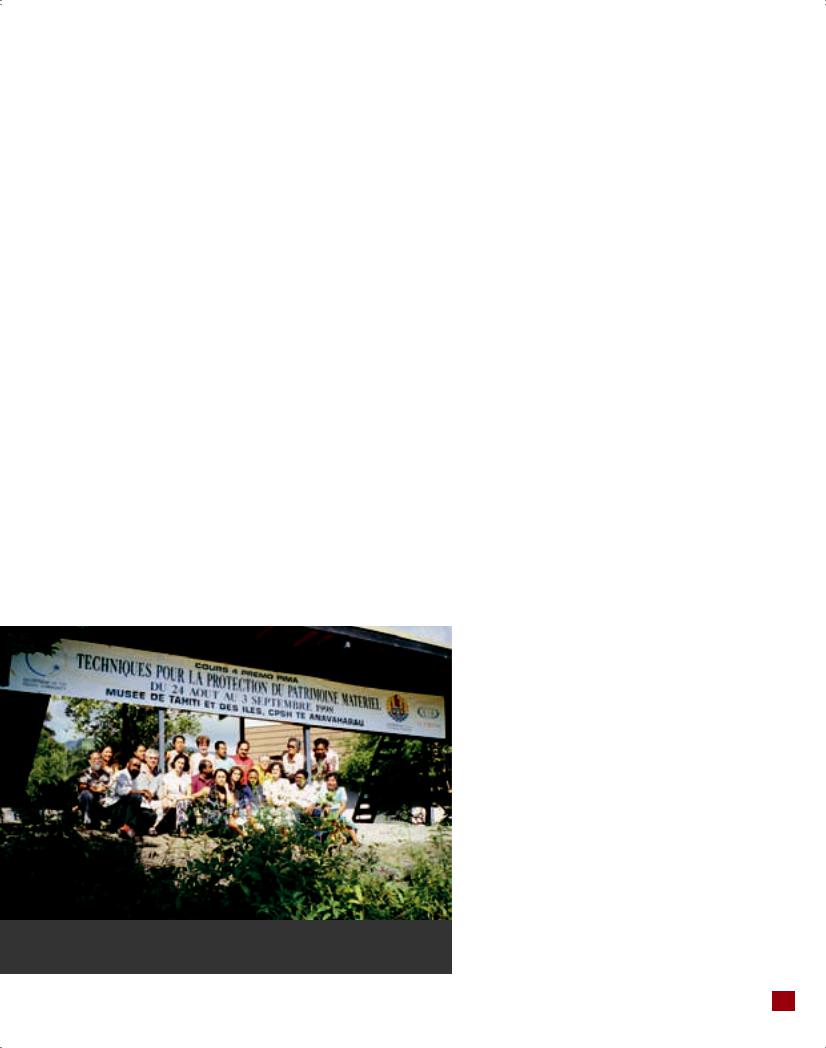
following missions: to encourage children to visit African national museums, to train and provide specialized and refresher courses for professionals n the field of movable and immovable cultural heritage, to undertake specialized research, to disseminate technical information and to initiate, advise on, execute and follow up cultural projects. The Programme for Museum Development in Africa (PMDA; now re-named the Centre for Heritage Development in Africa, CHDA) is a collaborative programme between ICCROM and the National Museums of Kenya (NMK) for the Anglophone countries of Africa. Its offices are in the historic building of the Old Law Courts in Mombasa, Kenya which were inaugurated in August 2000. It has links with over 400 professionals and researchers in Africa and abroad. The PREMA Network consists of trained, dedicated and motivated professionals working in various fields in the museums of subSaharan Africa.
tion and developing long-term, worldwide support for heritage preservation in the Pacific island states. One of the unique aspects of PREMO 1994-1998 was that all activities for collections preservation included objectives to preserve and develop living cultures. PREMO helped to establish a network of 22 island nations and to develop a database of professionals and institutions. Short practical training sessions and seminars were organized in various nations, including Noumea, New Caledonia (1994), Cook Islands National Museum, Rarotonga (1995) and Micronesia (1996). Another activity related to awareness-raising, using the experience of ICCROM’s Media Save Art Programme. The PREMO Programme received recognition within the UNESCO World Decade for Cultural Development, from the Australian National Commission for UNESCO and from the Fond de Coopération Economique, Sociale et Culturelle pour le Pacifique Sud (France).
PREMO
In 1991 ICCROM and the University of Canberra had launched the joint project for a programme of preventive conservation in museums of the Pacific States, i.e. Oceania, PREMO, modelled on the experience of PREMA and based on preparatory missions and feasibility studies carried out in 1991-92. The programme was launched for a five-year period, 1994-1998, directed by a regional co-ordinating board in the Pacific Island States, with ICCROM acting as a partner to assist the board in co-ordina-
Figure 6 18
PREMO Course in Tahiti, 1998
ARC and ITUC
At the 55th session of Council, the former chief of ICCROM’s Architectural Conservation Programme, now Assistant to Director-General, reported on the ARC programme activities in 1995:
“The International Architectural Course had been established in the sixties, and had trained more than 1,000 people. Two hundred and fifty professors had taught on this course. A new phase was beginning. The course had formed a reference model, which had been adopted by different countries and universities. It would become a forum for the exchange of experiences rather than training in specific skills. There would be more emphasis on issues related to buildings in one year, and on urban and rural settlements in another. As busy professionals had always less time to attend courses, the duration would be shorter. A course on urban and territorial conservation would start in 1997. Time would be allowed for a unit on risk preparedness. Activities would be more regionally oriented, such as North Africa, the Middle East and Central Asia initiatives, or thematic such as the GAIA program. In September a meeting in Teheran was attended by people from more than 20 countries in Central Asia and the Middle East, at which the current situation of these countries had been examined. A network was being formed to identify needs and formulate action within a specific framework, and a secretariat has already been set up for this network. Training had been done on a regional basis in Germany, Potsdam
6 New global challenges (1988-2005)  111
111
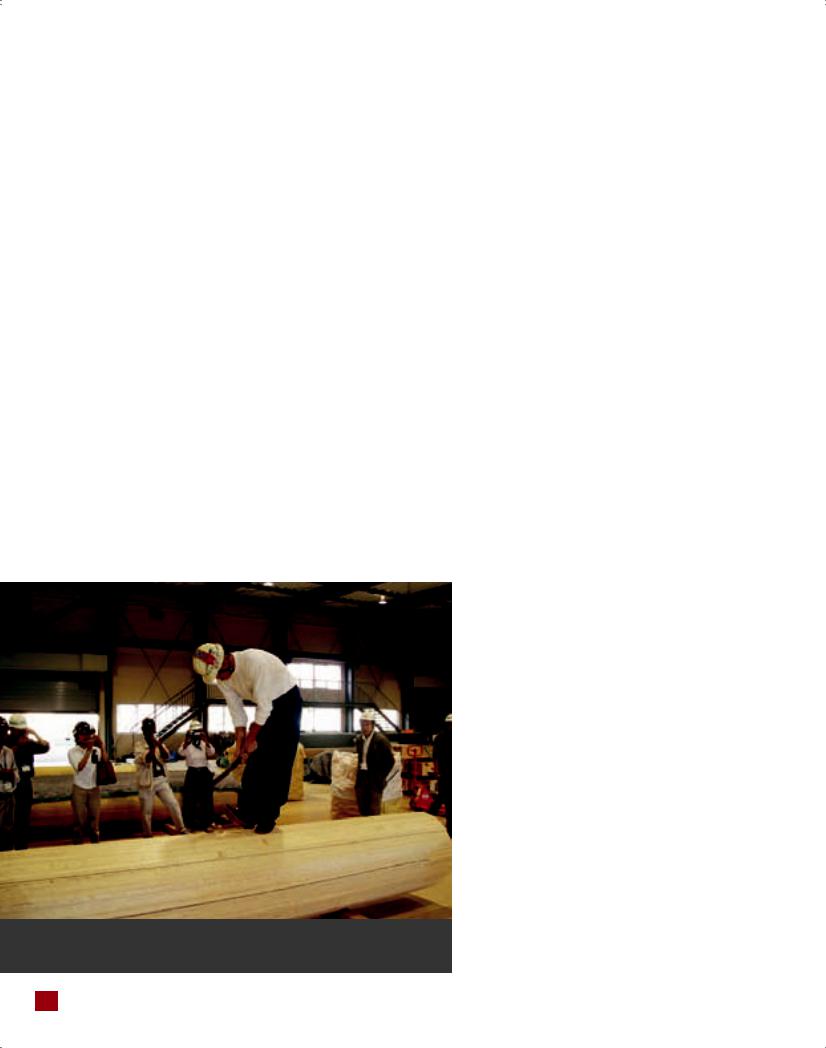
and Sans Souci, for cultural heritage ensembles, and in Cologne for cultural landscape issues.”258
This was the general trend of ICCROM’s programmes in the 1990s with the classic in-house programmes gradually transferred to the regions and/or replaced with new thematic activities. The ICCROM Architectural Conservation Course, coordinated by Andrea Urland was organized for the last time in the spring of 1998. At the same time ICCROM established new programmes such as NAMEC, SITES, ITUC, PAT and Africa 2009, which all benefited from the experience of the ARC programme.
The Austrian Council Member, Franz Neuwirth, commented later on ICCROM’s role in the development of training, noting the changes that had taken place in the conservation world:
“Yes, we have in the conservation a development of understanding the concept of monument, from a single structure to the cultural landscape. It is like a spiral. Taking the European Architectural Heritage Year 1975 as one reference, we have somehow made another circle, but we are now one level higher. Twenty-five years ago, we jumped from the monument to the ensemble; now we are doing a similar jump from the ensemble to the landscape. The problem today is that we are really lacking the instruments of
Figure 6-19
Wood Conservation Course in Nara, Japan
protection and conservation. The jump from a single structure to the ensemble was not so big as the current one. We now have a totally different situation. Two Austrians have participated in these new courses at ICCROM (ITUC). One of them, a lady, told me that she benefited a lot. She was educated to think about the monument, but in Rome she learnt to think of cultural heritage. That is one thing I want to mention.”259
NAMEC
Another programme activity concerned the historic cities of North Africa and the Near and Middle East Countries (NAMEC). Started in 1992 in the framework of collaboration with the Italian Government, it initially focused on three Maghreb countries: Algeria, Morocco and Tunisia. The three countries, the Italian Government and ICCROM defined its objectives as to establish a system for the monitoring and study of cultural property; to develop the regional network and training, and to organize the transfer of responsibilities to the countries concerned. Rather than introducing a foreign international team of experts, the survey and assessment were based on the conservation experts of the three countries. During the first phase of the programme in1992-93, a regional survey approach was prepared by the Survey Working Group with ICCROM acting as facilitator.
Resulting from the survey, and using the training models already developed by ICCROM, the NAMEC programme included a series of training activities. The first of these was the regional Architectural Conservation Course in Tunis, held in collaboration with
Institut National du Patrimoine (INP) of Tunisia (November 1994 to July 1996). This was a two-year master programme directed by Abdelaziz Daoulatli of INP and co-ordinated by Denis Lesage, a French architect. The course benefited from financial support from the Italian and French Governments, with the teaching faculty coming from the Maghreb countries, Italy, Spain and France. In 1996, in agreement with the Italian and Algerian Governments, ICCROM organized two five-month seminars on the conservation of historic buildings and settlements (COPAT) in Rome. One of these was addressed to technicians, the other to architects. Other programmes started in Morocco and Algeria in 1998 on the Scientific Principles of Moveable Property, Organic and Inorganic, which received additional funding from the European Union.
GAIA and TERRA
The six-year pilot phase of the GAIA project (19891995), in collaboration with CRATerre and EAG
 112
112 ICCROM and the Conservation of Cultural Heritage. A history of the Organization’s first 50 years, 1959-2009
ICCROM and the Conservation of Cultural Heritage. A history of the Organization’s first 50 years, 1959-2009
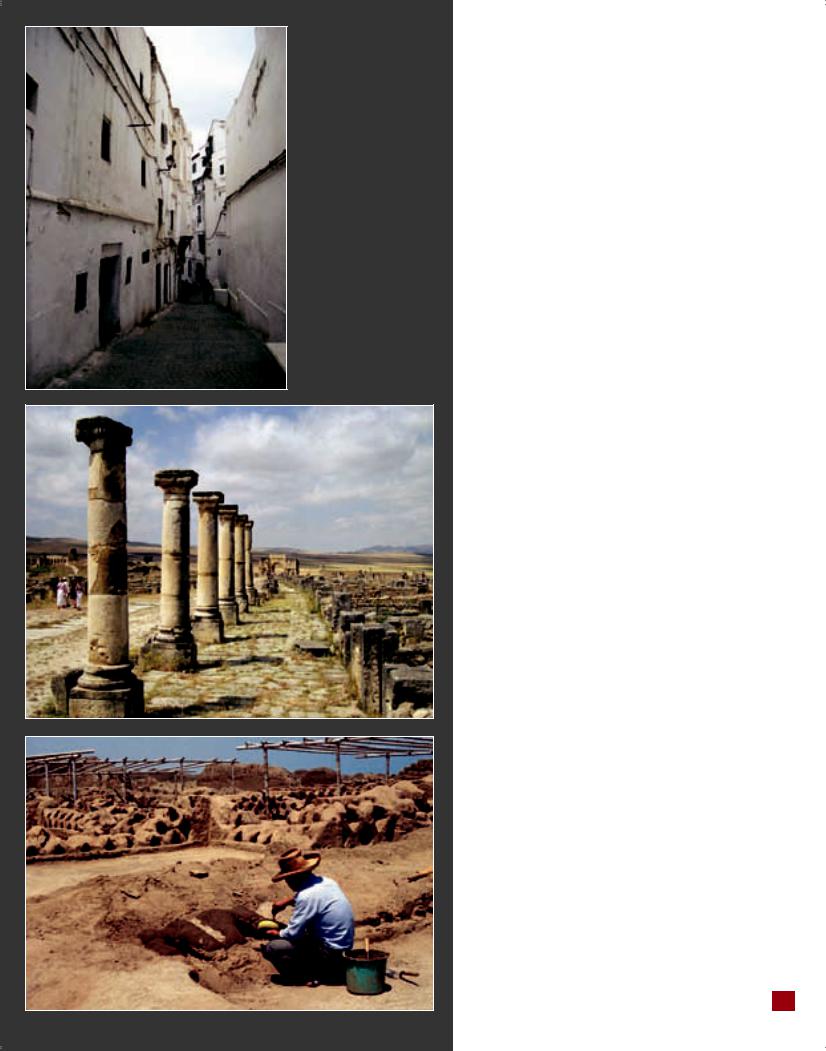
Figure 6 20
The NAMEC Programme was organized in collaboration with Algeria, Morocco and Tunisia (a street in the Casbah d’Alger)
Figure 6 21
The archaeological site of Volubilis, Morocco
Figure 6 22
The Pan-American Courses
in the Conservation and
Management of Earthen Architectural Heritage prepared a management plan for the World Heritage archaeological site of Chan Chan, Peru
(University of Grenoble, France), included international training programmes in Grenoble, research and technical cooperation. Continued cooperation in 1998-2002 with the International Centre for Earth Construction and the School of Architecture of Grenoble (CRATerre-EAG) led to development of the TERRA Project. The first phase saw the preparation of an International Bibliography on the Preservation and Rehabilitation of Earthen Architecture and collaboration with the PREMA programme to develop a maintenance programme for the royal palaces of Abomey in Benin, with a financial contribution from the Italian Government through UNESCO Funds-in-Trust. In 1996 and 1999 the programme continued in the form of Pan-American Courses in the Conservation and Management of Earthen Architectural Heritage held in Trujillo, Peru, organized in collaboration with the Peruvian authorities, the Getty Conservation Institute and CRATerre-EAG. The participants were architects, archaeologists and conservators from Latin American countries. The course participants developed a comprehensive management plan for the huge archaeological site of Chan Chan, ancient capital of the Chimu Kingdom and inscribed on the World Heritage List in 1986.
Science and technology
The Science and Technology Programme, directed by Marisa Laurenzi Tabasso, focused particularly on training programmes. The courses on Scientific Principles of Conservation (SPC) and the Conservation of Mural Paintings (MPC) were held regularly in Rome until 1994. From then on there was an increasing transfer of programmes to the regions and the regular courses in Rome were held for the last time in 1998. MPC was re-named Conservation of Mural Paintings and Related Architectural Surfaces and the regional courses often focused on architectural surfaces in general. In November 1999 ICCROM organized a research seminar on Graphic Documentation Systems in Conservation of Mural Paintings (GraDoc), the results of which were later published260 and, in 1997, an international course on non-destructive and micro-destructive analytical methods.
In view of the increasing role played by natural sciences in the conservation field, ICCROM took action to support the role of natural sciences in conservation. In 1997 it launched a worldwide Survey on Scientific Research for the Conservation of Physical Heritage (SRC) in order to investigate the present situation and medium-term trends. The survey showed that the relationship between SRC and training was mainly confined to the training of conservator-restorers and the professional profile
6 New global challenges (1988-2005)  113
113
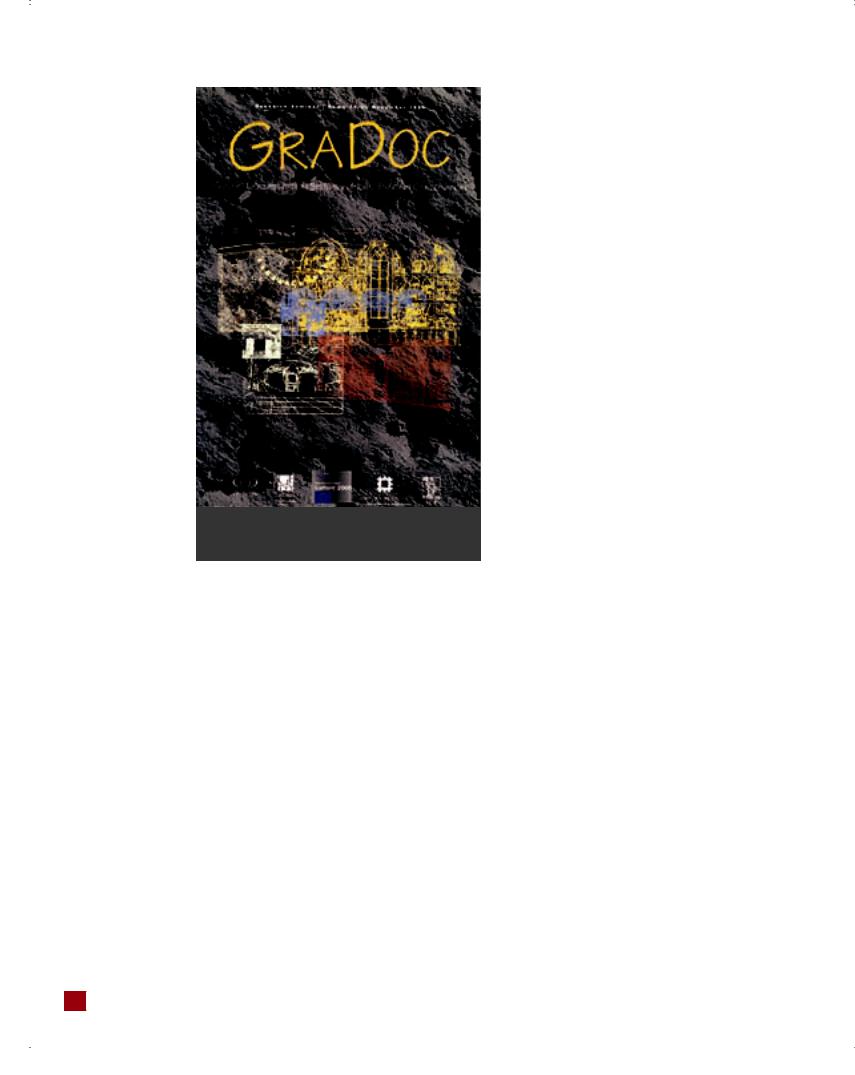
Figure 6 23
The GraDoc publication
of conservation scientists (CS) was poorly defined. ICCROM therefore introduced a new course specifically directed to conservation scientists in collaboration with IFROA (Institut de Formation des Restaurateurs d´Oeuvres d´Art, France), first in Paris and then in Rome (ANMET). In 1998 ICCROM undertook a further survey (supported by the European Commission) on the best ways to prepare conservation scientists in European countries, and the feasibility of a training curriculum for conservation scientists (CURRIC). These issues were the subject of an international meeting, organized in Bologna in November 1999, which was attended by some 50 representatives of scientific departments of universities and research institutions. The conclusions of the meeting resulted in the preparation and approval of the ‘Bologna Document’, which defined the role and professional profile requirements of conservation scientists:
“A Conservation Scientist (CS) today can be defined as a scientist with a degree in one of the natural, physical and/or applied scientific disciplines and with further knowledge in conserva-
tion (ethics, history, cultural values, historical technologies, past and present conservation technologies and practice, specific scientific aspects, etc.) which enables him/her to contribute to the study and conservation of Cultural Heritage within an interdisciplinary team.”
As a follow-up of the Bologna meeting, the CURRIC-LEONARDO project was launched by ICCROM, supported by ISFOL (the Leonardo da Vinci Italian National Agency) in collaboration with ten European universities and conservation research centres and managed by Rocco Mazzeo of ICCROM. The CURRIC project developed a post-graduate Vocational Training Curriculum for Conservation Scientists which, in the following years, was adopted for the first European Ph.D. for conservation scientists that was introduced by Bologna University in collaboration with the same CURRIC partners.
The SPC-MPC course models that had been developed at ICCROM were drawn upon in organizing training programmes on a variety of topics according to the needs of each region. In 1995 a regional Mural Paintings Course was organized in Transylvania, Romania and the Scientific Principles of Conservation (SPC) course was organized for the first time outside Rome in Belo Horizonte (Brazil) as a pilot programme with a duration of nine weeks (instead of the usual 18 weeks in Rome). It was repeated in 1998 in Minas Gerais, Brazil. In fact, in 1995 no courses were organized at ICCROM on Science and Technology. Instead ICCROM ran other courses on a variety of subjects: paper conservation courses in Vienna and Horn (Austria); conservation of Japanese Paper courses in Tokyo and Kyoto; and archival paper conservation courses in Santiago de Chile. In 1997, jointly with the Hungarian National Museum, it organized an international course in Budapest on the Scientific Principles of Textile Conservation and, in 1999, a regional course on the Conservation and Management of Rock-Art Sites in Southern Africa, held in Zimbabwe in collaboration with the national authorities of Zimbabwe and South Africa, with funding from ICCROM and the UNESCO World Heritage Fund.
The first Regional Stone Conservation Course for Central and Western Asia was organized by Iranian authorities in collaboration with ICCROM, which contributed to planning, defining the course curriculum and selection of lecturers. The 28 course participants were professionals from Armenia, Bangladesh, Iran, Jordan, Kyrgyzstan, Pakistan, Syria and Turkmenistan. The course was held mainly in Persepolis, taking this archaeological site as a case study. The course was part of a regional
 114
114 ICCROM and the Conservation of Cultural Heritage. A history of the Organization’s first 50 years, 1959-2009
ICCROM and the Conservation of Cultural Heritage. A history of the Organization’s first 50 years, 1959-2009
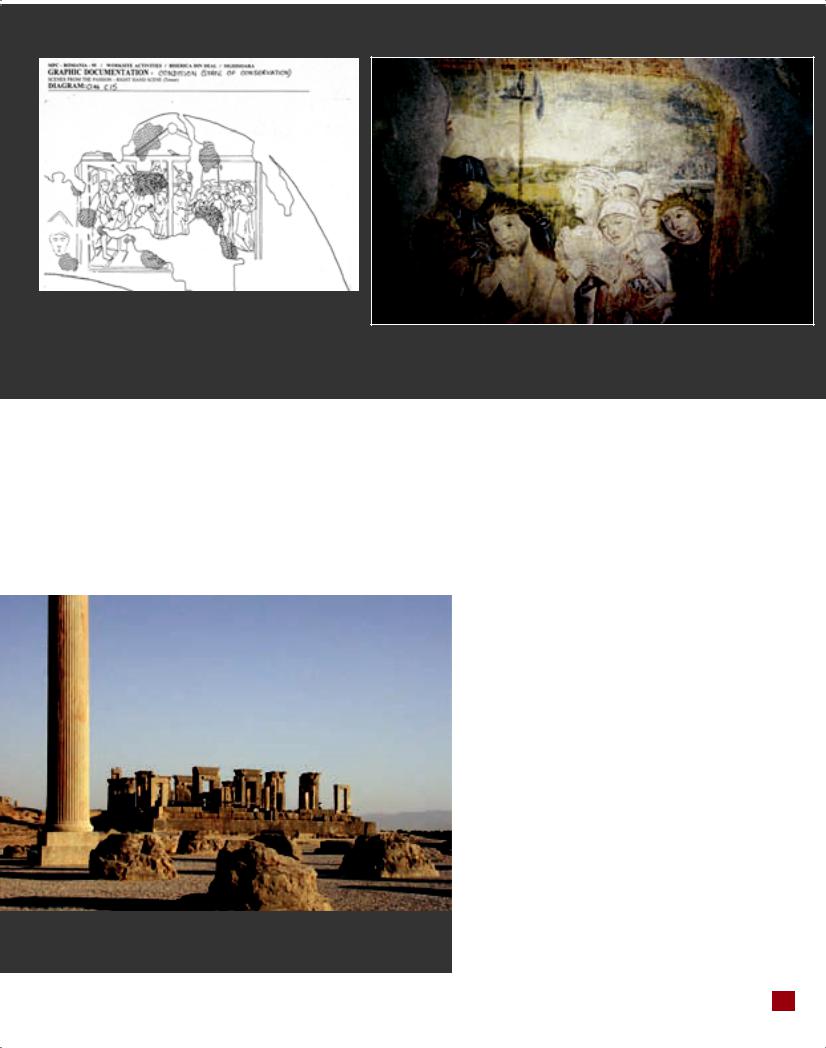
Figure 6 24
The mural painting illustrating the Passion (church in Sighisoara, Romania): a) graphic documentation of state of conservation, b) the painting after restoration by the Mural Paintings Course (MPC95)
programme development to include other training activities, conferences and technical cooperation. A National Course on Scientific Principles of Conservation of Archaeological Properties was organized in Jerusalem, January 1998-July 1999, in collaboration with the Conservation Department of the Israel Antiquities Authority. The course aimed at giving the participants the elements for a scientific approach to the conservation of archaeological properties.
Figure 6-25
The ancient site of Persepolis in Iran with Apadana and the Palace of Darius the Great
The new Didactic Laboratory at ICCROM, officially inaugurated in 1997, was dedicated to Harold Plenderleith in recognition of his merits as conservation scientist and of his generosity in having made a personal grant towards equipping the laboratory. One of the first activities of the Laboratory was the re-organization of the archive of samples collected from works of art by experts on the occasion of technical missions carried out on behalf of ICCROM. The Laboratory hosted the participants of various ICCROM courses, interns, and visiting professors, organized three international seminars on technical issues and published a Laboratory Handbook dedicated to the conservation of architectural heritage (structures and materials) that was financially supported by the World Heritage Centre.261 This handbook continued an ICCROM tradition of disseminating didactic scientific/technical information that had been initiated by G. Torraca in the 1970s.
The regional courses were carried out to the same high standards as those at ICCROM. If there was any difference, it lay principally in the topics that were covered by the programme. The courses were much appreciated by the participants. For example, a Chilean participant,262 referring to two courses in her country, wrote:
“For Chile, the most important benefit obtained from this experience has been a qualitative leap in the field of conservation in archives: we have achieved the consolidation of an important group of professionals. All those involved in the two courses as participants, assistants,
6 New global challenges (1988-2005)  115
115

collaborators or lecturers are now professionals that we can count on for consultancies, training and implementing projects in this area. ... The courses have functioned as catalysts for shaping actions that existed only as potential. Each event led to immediate and concrete benefits: for example, the 1994 course was a key factor in creating the Conservation Department at the National Library, which is currently carrying out a major conservation project employing five former participants. Similarly, the 1996 course provided the occasion for mounting a new conservation laboratory for the National Archive. ... After the courses and thanks to a variety of projects, other archival conservation laboratories have also been established (e.g., at the Archivo Andres Bello of the University of Chile and at the Archive of the Foreign Ministry, Santiago; at the Historical Archive of the Armada of Chile and that of the Lukas Foundation, Valparaiso), thus significantly increasing the number of specialized conservation units in the country. This situation has established a network of collaboration and professional exchange that contributes to the efficiency of the work being carried out, as well as facilitating new and major developments.”
Reflection on the period 1988-2000
The outgoing Director-General, Marc Laenen, in his Editorial in the ICCROM Newsletter 26,263 summarized the achievements of his past eight years. The aim had been to develop appropriate policies and frameworks, strengthen conservation institutions and services, contribute to the development of human resources, support the conservation profession and raise awareness of the importance of conserving cultural heritage. Laenen concluded his article:
“The eight years of intense collaboration have led to important new trends in the Organization. ICCROM has moved from being primarily an international training centre to being a platform of international solidarity where international, national and regional scientific organizations, institutes and development agencies cooperate (in the real sense of the word) to improve the professional and operational capacity of Member States to manage resources and promote understanding of the social values of heritage. While training remains one of our most important outputs, it is now included in a more global, multi-faceted approach. ICCROM offers a politically neutral platform where joint financial and
logistical efforts have an important leverage effect, and its contribution remains technical and managerial. In doing so, ICCROM slowly moves into the meaning of its vision: to be ‘The Crossroads of People, Ideas, and Action at the Service of Cultural Heritage World-wide’.”
In this period ICCROM made a great effort to assess its achievements and to plan strategies for the future. This is a continuous process, of course. Laenen’s mandate gave ICCROM a revised standing. At the same time, it marked the end of a period that also saw the retirement of several senior staff members, opening up the possibility for a new director to reconsider the balance of personnel.
Refining the quality (2000-2005): the directorship of Nicholas Stanley-Price
The General Assembly elected Dr. Nicholas Stan- ley-Price (UK) Director-General in 2000. With a doctorate in archaeology, he had worked as an archaeologist in the Eastern Mediterranean and the Middle East, and was then on the staff of ICCROM from 1982 to 1986 as Assistant Co-ordinator of the Scientific Principles of Conservation Course. At the Getty Conservation Institute (1987-1995), in Los Angeles, he promoted archaeological conservation and professional education, going on to the Institute of Archaeology of the University College London where he introduced a new MA in site conservation and management. He had published a number of books, including Historical and Philosophical Issues
Figure 6 26
Nicholas Stanley-Price,
Director-General of
ICCROM, 2000-2005
 116
116 ICCROM and the Conservation of Cultural Heritage. A history of the Organization’s first 50 years, 1959-2009
ICCROM and the Conservation of Cultural Heritage. A history of the Organization’s first 50 years, 1959-2009

Figure 6 27
Bamiyan cliff with niche of the destroyed western Buddha (photo A. Miller)
in the Conservation of Cultural Heritage (Getty Conservation Institute, 1996, co-edited jointly with Mansfield Kirby Talley, Jr., and Alessandra Melucco Vaccaro) and had founded and edited the quarterly journal Conservation and Management of Archaeological Sites.
Challenges of the period
The Editorials published by the Director-General in the ICCROM Newsletter give a good idea of the challenges that ICCROM perceived in this period. In the Newsletter 27 of 2001, Stanley-Price raised the issues of the destruction, in March 2001, of the Buddha statues in the Bamiyan Valley in Afghanistan, a site that had been proposed to the World Heritage List before the long series of armed conflicts but had been deferred subject to improving its management (it was inscribed in 2003).
The Director-General raised another issue about the role of heritage in a globalizing society:
“In the first dawn of the new millennium, two controversies in particular have raised fundamental issues for those concerned with the preservation of cultural heritage. One was associated quite specifically with the threat and then the actual act of deliberate destruction of the two rock-cut statues of the Buddha at Bamiyan in Afghanistan in March 2001. The other is the wider, continuing debate over the benefits and
costs of the globalization of society, which popular concern has forced onto the meeting agenda of the world’s political leaders. Both debates have profound implications for an international. intergovernmental organization such as ICCROM that is devoted to the preservation of cultural heritage. There are implications in the demolitions at Bamiyan for re-thinking several premises on which cultural heritage preservation is based, for instance the notion of a universal heritage value. The ramifications of the globalization debate may appear to be less immediately relevant. But it raises important questions about preserving cultural diversity (and not least its material form) in the face of the increasing homogenization of world culture. Moreover. at a more mundane but nonetheless real level, global climate change is apparently threatening the physical survival of cultural heritage (for instance through sea-level change, severe flooding, and atmospheric pollution).”264
Stanley-Price observed that it was in the area of cultural understanding that the challenges arose. They would arise in situations that require understanding across cultures and disciplines, between professionals and non-professionals, young and old. Therefore, the issues of training and advocacy, part of the long-term mission of ICCROM, showed their relevance in today’s world. The goals necessarily had
6 New global challenges (1988-2005)  117
117
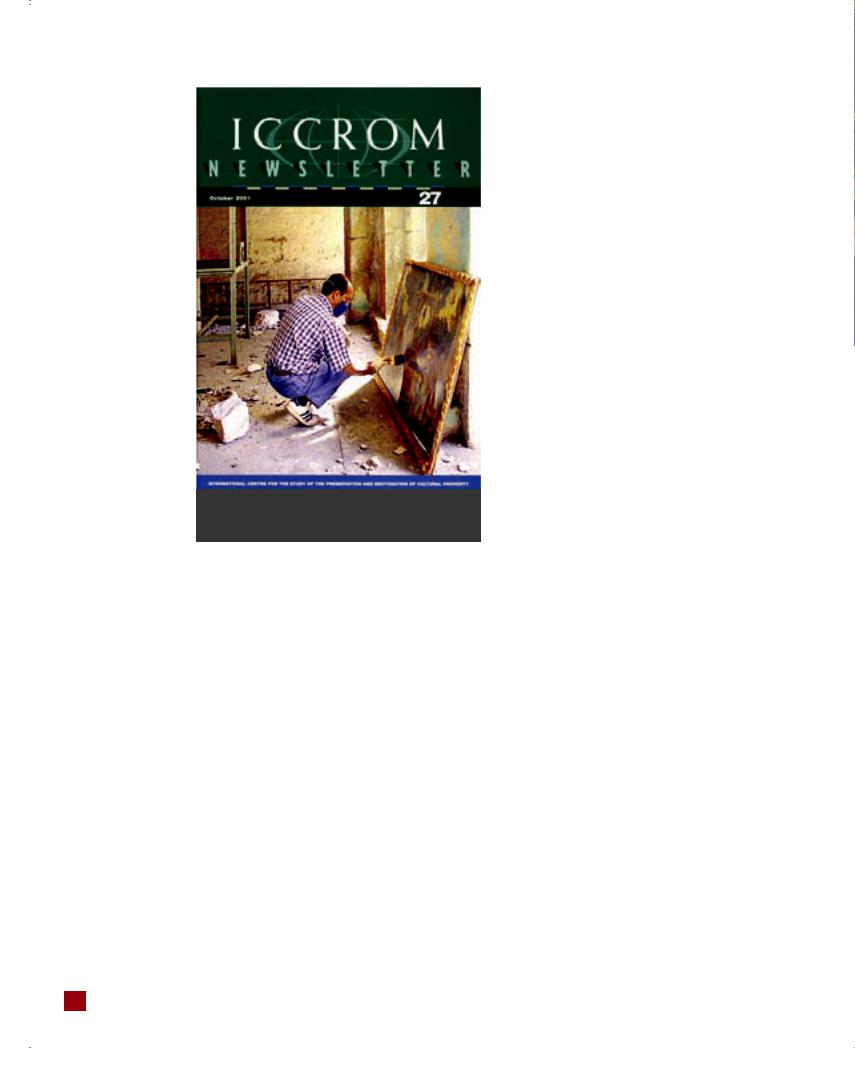
Figure 6 28
ICCROM Newsletter 27 (October 2001)
to be adjusted over time, and the need to introduce communication skills in training curricula should be taken as an important asset, something that had already been adopted at ICCROM.
The United Nations declared 2002 the Year for Cultural Heritage, and UNESCO stated that “the biggest challenge is to make the public authorities, the private sector and civil society as a whole realize that cultural heritage is not only an instrument for peace and reconciliation but also a factor of development.”265 The year 2002 was also designated by the UN as the Year of Ecotourism, a concept that could raise similar issues. At the same time, the definition of what constitutes ‘heritage’ continued to expand, and new topics tended to attract resources away from existing ones. Stanley-Price referred to ICCROM’s statutory mission to provide information, its databases and its international library. The approval of a 4% increase in Member State regular contributions at the General Assembly in November 2001 made it possible to appoint an archivist and a Publications Manager, essential components for carrying out the information strategy of ICCROM.
In 2003 Stanley-Price referred to the wartime destruction of cultural heritage in Iraq, and the losses
particularly of museums, libraries and archive collections. He observed that more attention had been given to movable than to immovable cultural property, and raised the issue of the distinction between these two. He asked if this distinction was still useful, and what was the relationship of ‘property’, which was for example in ICCROM’s name, compared to ‘heritage’. The latter term grew increasingly popular from the 1960s, to be used in the 1969 European Convention on the Protection of the Archaeological Heritage, followed by UNESCO’s 1972 Convention concerning the Protection of the World Cultural and Natural Heritage (though the List still speaks of ‘properties’). He noted that, fortunately, ICCROM had been founded as a centre for conservation of all types of cultural property, movable and immovable. Another sign of integration was the International Committee of the Blue Shield (ICBS) that brought together four international NGOs representing the different fields, including ICOM, ICOMOS, IFLA (International Federation of Library Associations and Institutions), and ICA (International Council of Archives), and where UNESCO and ICCROM held consultative status.266 ICCROM’s bilingual course, Sharing Conservation Science: vers un langage commun, which was first held in Paris in 2001, was also an excellent example of bringing the different disciplines together in a training context. He concluded by stressing the need for greater integration, and noted:
“The ability of conservation professionals to work interculturally has never been more important. It is a skill that is increasingly in demand in their daily working contexts in our multicultural societies. It is in even greater demand should they find themselves called upon to aid in recovery operations abroad when cultural heritage is damaged by natural disaster or armed conflict. The preparation of specialists who, irrespective of disciplinary background, show a sympathetic understanding of culturally diverse traditions while coping with limited resources and difficult environments, remains a high priority in the conservation field.”267
In 2004, the Director-General drew attention to living religious heritage, under the title: Living religious heritage: conserving the sacred.268 He noted that cultural heritage was often used as a weapon in the conflicts that could be provoked by competing faiths. As a result, places and ritual objects might be demolished to gain a temporary ascendancy over another. However, he pointed out that there were many other challenges, such as changing functional and ritual needs, competing claims of
 118
118 ICCROM and the Conservation of Cultural Heritage. A history of the Organization’s first 50 years, 1959-2009
ICCROM and the Conservation of Cultural Heritage. A history of the Organization’s first 50 years, 1959-2009

Figure 6 29
Living Heritage programme in Sri Lanka, 2005
coexisting faiths, fluctuating adherence to religion or to freedom of worship, secularization of society and growth of tourism, as well as museification and the potential tension between ‘scientific’ conservation and continuity of the religious tradition. These were questions that were taken up in the ICCROM Forum 2003, which focused on the subject.269 He concluded by saying that heritage that is recognized to have living religious values would always present different conservation challenges compared to one that is mainly recognized as a historic monument or represented as museum exhibit. The cases presented in the Forum showed that there was need for compromise and tolerance of different ways of working, but mutual understanding could be achieved acknowledging the needs of both faith and conservation.
The issue of disaster recovery was again in focus, following the devastating earthquake and consequent tsunami in the Indian Ocean on 26 December 2004. Stanley-Price commented that it was especially in the area of community life and traditions that culture makes an essential contribution to recovery efforts. While it is urgent to organize immediate assistance to survivors, the cultural and particularly religious buildings often tend to survive earthquakes due to their more solid structure. They also easily become symbols of continuity. He referred to the guidelines by the National Physical Planning Department in Sri Lanka, which acknowledged the importance of cultural heritage in reconstruction:
“The necessity to re-plan the urban areas should be used as an opportunity to create better and
sustainable urban environments. It is of prime importance, however, to retain the regional flavour in terms of architectural and historical integrity and uniqueness of the individual towns. Conservation of historic structures must be given the consideration in redevelopment plans. Activities that need to be relocated owing to their incongruity, obsolescence or any other reason should be found alternative lands.”270
The Director-General noted, however, that the crucial role of culture in diminishing the worst effects of natural disasters was still inadequately acknowledged. Instead of representing a curiosity, it should find a central place in all risk management strategies. Indeed, the importance of improving the practice of architectural conservation also meant raising the standards of recording, documentation, inventories and information management. These already formed part of the ICCROM tradition, and continued being introduced in the form of updated training programmes. Referring to the 2004 tsunami, Stanley-Price exclaimed: 271
“Out of this tragedy there must develop a greater awareness of the need to be prepared for such risks. Expensive high-tech early warning systems have their place in strategies for greater preparedness. But so do traditional knowledge and cultural heritage. Both must be exploited to the full in strengthening people’s ability to withstand the forces of nature in even the most extreme conditions.”
Figure 6 30
Natural disasters: devastation following the tsunami of 2004
6 New global challenges (1988-2005)  119
119
